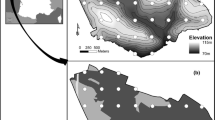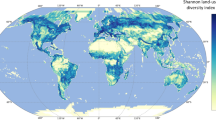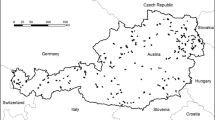Abstract
In the last 50 years, intensive agriculture has replaced large tracts of rainforests. Such changes in land use are driving niche-based ecological processes that determine local community assembly. However, little is known about the relative importance of these anthropogenic niche-based processes, in comparison to climatic niche-based processes and spatial processes such as dispersal limitation. In this study, we use a variation partitioning approach to determine the relative importance of land-use change (ranked value of forest loss), climatic variation (temperature and precipitation), and distance between transects, on bird beta diversity at two different spatial scales within the Western Ghats–Sri Lanka biodiversity hotspot. Our results show that the drivers of local community assembly are scale dependent. At the larger spatial scale, distance was more important than climate and land use for bird species composition, suggesting that dispersal limitation over the Palk Strait, which separates the Western Ghats and Sri Lanka, is the main driver of local community assembly. At the smaller scale, climate was more important than land use, suggesting the importance of climatic niches. Therefore, to conserve all species in a biodiversity hotspot, it is important to consider geographic barriers and climatic variation along with land-use change.



Similar content being viewed by others
Data accessibility
Data are available from Dryad Digital Repository https://dx.doi.org/10.5061/dryad.vk070 (Mammides et al. 2015).
References
Audino LD, Murphy SJ, Zambaldi L, Louzada J, Comita LS (2017) Drivers of community assembly in tropical forest restoration sites: role of local environment, landscape and space. Ecol Appl 20:1469–1478
Bagchi R, Philipson CD, Slade EM et al (2011) Impacts of logging on density-dependent predation of dipterocarp seeds in a South East Asian rainforest. Philos Trans R Soc B 366:3246–3255
Baldi G, Texeria M, Martin OA et al (2017) Opportunities drive global distribution of protected area. PeerJ 5:e2989
Baselga A (2010) Partitioning the turnover and nestedness components of beta diversity. Glob Ecol Biogeogr 19:134–143
Baselga A, Orme CDL (2012) Betapart: an r package for the study of beta diversity. Methods Ecol Evol 3:808–812
Becca G, Vancine MH, Carvalho CS et al (2017) High mammal turnover in forest patches immersed in biofuel plantations. Biol Conserv 210:352–359
Blanchet FG, Legendre P, Borcard D (2008) Forward selection of explanatory variables. Ecology 89:2623–2632
Bossuyt F, Meegaskumbura M, Beenaerts N et al (2004) Local endemism within the Western Ghats–Sri Lanka biodiversity hotspot. Science 306:479–481
Bueno AS, Bruno RS, Pimentel TP, Sanaiotti TM, Magnusson WE (2012) The width of riparian habitats for understorey birds in an Amazonian forest. Ecol Appl 22:722–734
Chase JM, Myers JA (2011) Disentangling the importance of ecological niches from stochastic processes across scales. Philos Trans R Soc B 366:2351–2363
Chen Y, Yuan Z, Li P, Cao R, Jia H, Ye Y (2016) Effects of environment and space on species turnover of woody plants across multiple forest dynamic plots in East Asia. Front Plant Sci 7:1533
Corlett RT, Westcott DA (2013) Will plant movements keep up with climate change? Trends Ecol Evol 28:482–488
Davey CM, Devictor V, Jonzen N, Lindstrom A, Smith HG (2013) Impact of climate change on communities: revealing species’ contribution. J Anim Ecol 82:551–561
Dray S, Blanchet G, Borcard D, Guenard G, Jombart T, Larocque G et al (2016) Adespatial: multivariate multiscale spatial analysis. R Package Version 0.03.
Elsen PR, Monahan WB, Merenlender AM (2018) Global patterns of protection of elevational gradients in mountain ranges. Proc Natl Acad Sci USA 115:6004–6009
Flick SE, Hijmans RJ (2017) WorldClim 2: new 1-km spatial resolution climate surfaces for global land areas. Int J Climatol 37:4302–4315
Freeman BG, Freeman AM (2014) Rapid upslope shifts in New Guinean birds illustrate strong distributional responses of tropical montane species to global warming. Proc Natl Acad Sci USA 111:4490–4494
Friess N, Muller JC, Aramendi P, Cassler C, Brandle M, Bouget C (2019) Arthropod communities in fungal fruitbodies are weakly structured by climate and biogeography across European beech forests. Divers Distrib. https://doi.org/10.1111/ddi.12882
Goodale E, Kotagama SW, Raman TRS, Sidhu S, Goodale U, Parker S, Chen J (2014) The response of birds and mixed-species bird flocks to human-modified landscapes in Sri Lanka and southern India. For Ecol Manag 329:384–392
Gunatilleke CVS, Ashton PS (1987) New light on the plant geography of Ceylon II. The ecological biogeography of the lowland endemic tree flora. J Biogeogr 14:295–327
Gunawardene NR, Daniels AED, Gunatilleke IAUN et al (2007) A brief overview of the Western Ghats–Sri Lanka biodiversity hotspot. Curr Sci 93:1567–1572
Hijmans RJ, Williams E, Vennes C (2011) Package ‘geosphere’. https://cran.r-project.org/web/packages/geosphere. Accessed 10 Mar 2017
Hubbell SP (2001) The unified neutral theory of biodiversity and biogeography. Princeton University Press, Princeton
Karp DS, Frishkoff LO, Echeverri A, Zook J, Juarez P, Chan KMA (2018) Agriculture erases climate-driven β-diversity in neotropical bird communities. Glob Chan Biol 24:338–349
Kotagama SW, Ratnavira G (2010) An illustrated guide to the birds of Sri Lanka. Field Ornithology Group of Sri Lanka, Colombo
Kraft NJB, Comita LS, Chase JM et al (2011) Disentangling the drivers of β-diversity along latitudinal and elevational gradients. Science 333:1755–1758
Legendre P, Legendre L (2012) Numerical ecology, 3rd edn. Elsevier, Amsterdam
Legendre P, Mi X, Ren H, Ma K, Yu M, Sun I, He F (2009) Partitioning beta diversity in a subtropical broad-leaved forest of China. Ecology 90:663–674
Mammides C, Chen J, Goodale UM, Kotagama SW, Sidhu S, Goodale E (2015) Data from: does mixed-species flocking influence how birds respond to a gradient of land-use intensity? Dryad Digit Repos. https://doi.org/10.5061/dryad.vk070
Mori AS, Isbell F, Seidl R (2018) β-diversity, community assembly and ecosystem functioning. Trends Ecol Evol 33:549–564
Myers JA, Chase JM, Jimenez I et al (2013) Beta-diversity in temperate and tropical forests reflects dissimilar mechanisms of community assembly. Ecol Lett 16:151–157
Myers JA, Chase JM, Crandall RM, Jimenez I (2015) Disturbance alters beta-diversity but not relative importance of community assembly mechanisms. J Ecol 103:1291–1299
Nekola JC, White PS (1999) The distance decay of similarity in biogeography and ecology. J Biogeogr 26:867–878
Newbold T, Hudson LN, Hill SLL et al (2016) Global patterns of terrestrial assemblage turnover within and among land uses. Ecography 39:1151–1163
Palmeirim AF, Benchimol M, Morante-Filho JC, Vieira MV, Peres CA (2018) Ecological correlates of mammal β-diversity in Amazonian land-bridge islands: From small- to large-bodied species. Divers Distrib 24:1109–1120
Pan GB, Kumar KR (1997) Climates of South Asia. Wiley, New York
Pascal JP, Ramesh BR, Franceschi DD (2004) Wet evergreen forest types of the southern western ghats, India. Trop Ecol 45:281–292
Pearson DE, Ortega YK, Eren Ö, Hierro J (2018) Community assembly theory as a framework for biological invasions. Trends Ecol Evol 33:313–325
Peres-Neto PR, Legendre P, Dray S, Borcard D (2006) Variation partitioning of species data matrices: estimation and comparison of fractions. Ecology 87:2614–2625
R Core Team (2018) R: a language and environment for statistical computing. R foundation for statistical computing, Vienna
Ramachandran V, Robin VV, Tamma K, Ramakrishnan U (2017) Climatic and geographic barriers drive distributional patterns of bird phenotypes within peninsular India. J Avian Biol 48:620–630
Raman TRS, Sukumar R (2002) Responses of tropical rainforest birds to abandoned plantations, edges and logged forest in the Western Ghats, India. Anim Conserv 5:201–216
Ranganathan J, Daniels RJR, Chandran MDS, Ehrlich PR, Daily GC (2008) Sustaining biodiversity in ancient tropical countryside. Proc Natl Acad Sci USA 105:17852–17854
Rasmussen PC, Anderton JC (2012) Birds of South Asia: the Ripley guide. Smithsonian National Museum of Natural History, Washington DC
Ricklefs RE (1987) Community diversity—relative roles of local and regional processes. Science 235:167–171
Ricklefs RE (2004) A comprehensive framework for global patterns in biodiversity. Ecol Lett 7:1–15
Robin VV, Vishnudas CK, Gupta P, Ramakrishnan U (2015) Deep and wide valleys drive nested phylogeographic patterns across a montane bird community. Proc R Soc B 282:20150861
Sam K, Koane B, Bardos DC, Jeppy S, Novotny V (2019) Species richness of birds along a complete rainforest gradient in the tropics: habitat complexity and food resources matter. J Biogeogr 46:279–290
Sinnott RW (1984) Virtues of the Haversine. Sky Telesc 68:159
Sørensen T (1948) A method of establishing groups of equal amplitude in plant sociology based on similarity of species and its application to the analyses of the vegetation on Danish commons. Biologiske Skrifter 5:1–34
Sreekar R, Srinivasan U, Mammides C et al (2015) The effect of land-use on the diversity and mass-abundance relationships of understorey avian insectivores in Sri Lanka and southern India. Sci Rep 5:11569
Sreekar R, Corlett RT, Dayananda S et al (2017) Horizontal and vertical species turnover in tropical birds in habitats with differing land use. Biol Lett. https://doi.org/10.1098/rsbl.2017.0186
Venter O, Fuller RA, Segan DB et al (2014) Targeting global protected area expansion for imperiled biodiversity. PLOS Biol 12:e1001891
Venter O, Magrach A, Outram N et al (2018) Bias in protected area location and its effects on long-term aspirations of biodiversity conventions. Conserv Biol 32:127–134
Vijayakumar SP, Menezes RC, Jayarajan A, Shanker K (2016) Glaciations, gradients, and geography: multiple drivers of diversification of bush frogs in the Western Ghats escarpment. Proc R Soc B. https://doi.org/10.1098/rspb.2016.1011
Wearn OR, Carbone C, Rowcliffe JM, Pfeifer M, Bernard H, Ewers RM (2019) Land-use change alters the mechanisms assembling rainforest mammal communities in Borneo. J Anim Ecol 88:125–137
Wickramasinghe N, Robin VV, Ramakrishnan U, Reddy S, Seneviratne SS (2017) Non-sister Sri Lankan white-eyes (genus Zosterops) are a result of independent colonizations. PLoS ONE 12:e0181441
Wiens JA (1989) Spatial scaling in ecology. Funct Ecol 3:385–397
Acknowledgements
We are grateful to A. Jayarathna, R. M. Pathiraja, G. Ramachandran, W. Ranjith, M. V. I. Sanjeewanie, H. Sathischandra and S. Sidhu for collecting bird data. We thank T. R. S. Raman for overseeing the project in India. This study was supported by the Conservation, Food and Health Foundation and the American Institute for Indian Studies. E.G. appreciates the support of the Special Talents Recruitment Program of the People’s Republic of China and the Special Talents Recruitment Fund of Guangxi University during write up. Adelaide Scholarship International and Australian Research Council supported R.S. and L.P.K., respectively. We thank two anonymous reviewers for their constructive comments and suggestions.
Author information
Authors and Affiliations
Contributions
RS, LPK, CM, RTC, SD, and EG designed the study; UM, SWK, and EG acquired bird data; RS analyzed the data and drafted the article; all authors contributed to manuscript writing and approved for publication.
Corresponding author
Ethics declarations
Conflict of interest
The authors have no competing interests.
Additional information
Communicated by Indrikis Krams.
There are multiple drivers of bird community assembly and the relative importance of each driver changes with spatial scale. Climate can be as important as land use for shaping bird communities.
Electronic supplementary material
Below is the link to the electronic supplementary material.
Rights and permissions
About this article
Cite this article
Sreekar, R., Koh, L.P., Mammides, C. et al. Drivers of bird beta diversity in the Western Ghats–Sri Lanka biodiversity hotspot are scale dependent: roles of land use, climate, and distance. Oecologia 193, 801–809 (2020). https://doi.org/10.1007/s00442-020-04671-3
Received:
Accepted:
Published:
Issue Date:
DOI: https://doi.org/10.1007/s00442-020-04671-3




